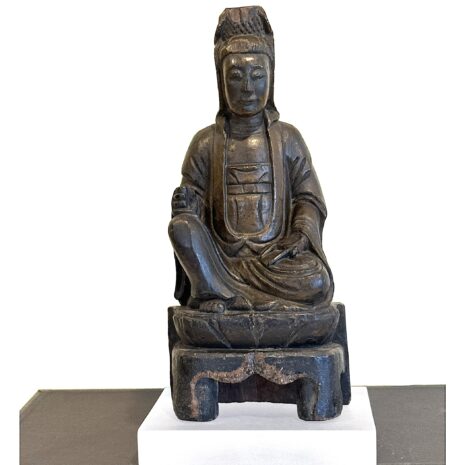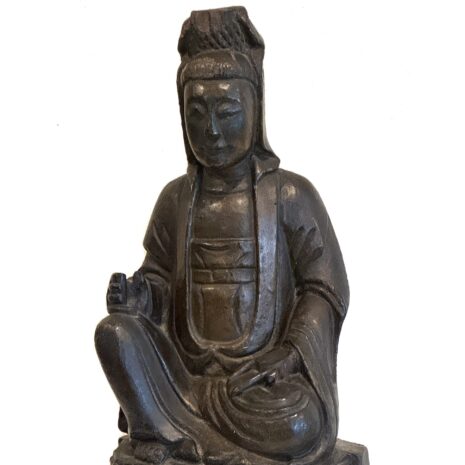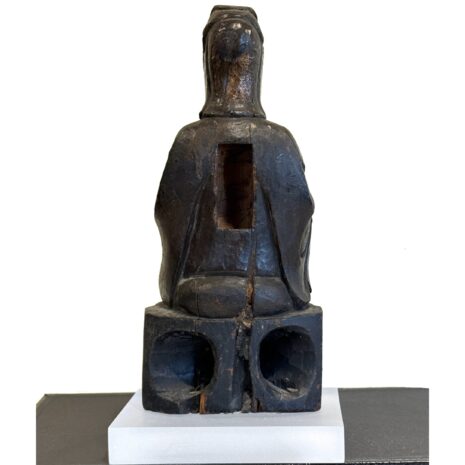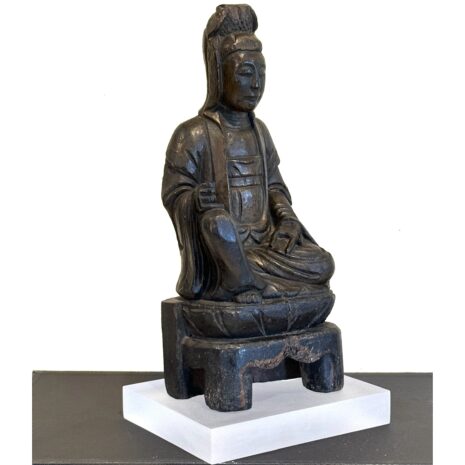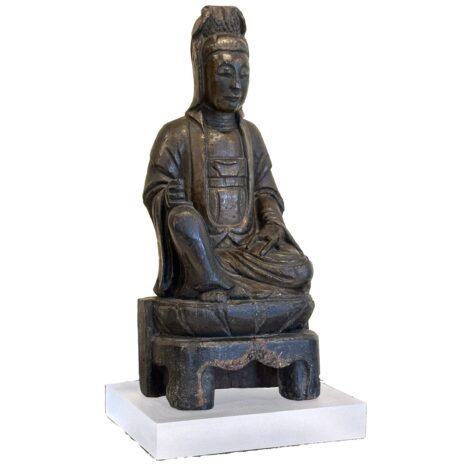Antique White Hooded Guanyin in Royal Ease Guanyin ( Lalitsana), China, (16910)
Original price was: $785.00.$625.00Current price is: $625.00.
H: 10.75″ W: 5.5″ D: 4.5″ | FREE SHIPPING IN CONTINENTAL U.S.
White clad Guanyin in royal ease and karana mudra to expel evil, remove problems and rid sickness or other negativities rarely used for Guanyin. Consecrated for home altar use.
Description
During the Ming and Qing dynasties, local artists created small Guanyin statues for private home altars, community shrines and local temples. Although a Buddhist deity, Guanyin was embraced in Taoism and Popular Folk Religion. Sanctioned images and those for wealthier devotees were created in porcelain, jade, bronze and ivory; those for Popular Folk Religion devotees and those of lesser wealth were made from soft stone and wood.
Guanyin has 33 manifestations, one of the most popular was “White Hooded” Guanyin – a modest goddess with a hood-like garment covering her head. The head covering reflects her feminized role and her importance as a compassionate maternal figure. As here, she exudes a sense of peace, infinite benevolence and grace with a gentle downcast gaze as if listening to the cries of humanity.
She is shown in the Pose of Royal Ease (lalitsana), as a regal bodhisattva who presides over the material and spiritual world. Her right leg is bent, the left lies flat as she sits in serene contemplation and effortless grace. The relaxed pose conveys a peaceful accessibility, showing that enlightened beings are remain gentle and approachable while compassionately helping all sentient beings alleviate their suffering.
Her right arm relaxes on her right raised knee, while her left is in her lap in a gesture of strength and empowerment called the “Gesture for Warding off Evil (Karana Mudra). The thumb holds the middle and ring fingers down while the index and pinky are extended. This unique mudra helps devotees overcome internal and external challenges and symbolizes Guanyin’s ability to protect and repel evil spirts, harmful thoughts and negative energies. It removes obstacles that hinder spiritual progress such as anxiety, fear, depression while promoting uplifting emotions like serenity, joy and peace. She sits on a lotus, a base used for enlightened beings, as symbol of purity and enlightenment. It signifies harmony and peace, reflecting Guanyin’s role as the Goddess of Mercy and Compassion who helps sentient beings manage their suffering.
Small Guanyin statues were often placed on home altars with other Buddhist, Taoist and Popular Religion deities and ancestor figures to nurture a sense of calm and compassion. Offerings were placed in front of them as a sign of respect and honor and to usher in good fortune and prosperity. It is thought that having a statue in the Karana Mudra can foster feelings of inner peace and safety by minimizing negativity energy from one’s mind and surroundings. Guanyin reminds us that we all have the power to overcome fears, doubts and negative emotions to help us reach a higher state of awareness and spiritual fulfillment.
In excellent condition and mounted on a frosted acrylic stand, it was consecrated by a monk as indicated by the cavity in the back.
Additional information
| Weight | 5 lbs |
|---|---|
| Dimensions | 14 × 10 × 6 in |
| Place of Origin | China |
| Period | Antique, Qing Dynasty |
| Date | 18-19th Century |
| Materials and Technique | Wood |
| Dimensions (inches) | Ht: 10.75” W: 5.5” D: 4.5” |
| Dimensions (metric) | Ht: 27.3cm W: 13.97cm D: 10.16cm |
| Weight | 2lbs |
| Condition | Excellent, age appropriate signs of wear |
| Shipping Box Size |

